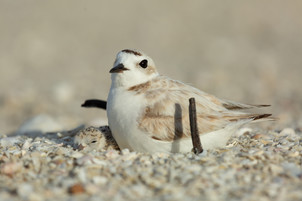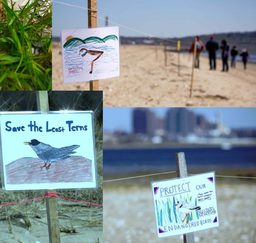FSA Partnership Meetings:
October 3: Lee/Collier Partnerships, 1-4:30pm, Florida Gulf Coast University. Contact Adam Dinuovo.
October 10: Panhandle Working Group, Gulf Coast State College. Contact FSA Coordinator.
October 10: Suncoast Partnership, 12-2pm, Eckerd College. Contact Beth Forys.
October 18: St. Johns/Flagler Partnership, 1-4pm, Alligator Farm. Contact Jean Olbert.
October 24: Space Coast Partnership, 1-4pm, Kiwanis Island Park, Contact Anna Deyle.
October 28: Timucuan Partnership, 10am-1pm, Ribault Club, Contact Blair Hayman.
November 18: Nature Coast Partnership, 1-4pm, Nature Coast Biological Field Station. Contact Megan Wallrichs.
Events:
October 1: Florida Shorebird Data Entry Deadline
October 10: Shorebird Walk at Matanzas Inlet
October 12: Shorebird Walk with Holley Short of Florida Audubon, 8am, Gandy Beach, Pinellas County. Contact Holley.
October 17-20: Florida Birding & Nature Festival
October 25-26: Florida Audubon Assembly

Snowy Plovers Take Advantage of Hurricane-altered Landscape
Most Floridians are familiar with the destructive and transformative power of hurricanes. As a Category 5 storm (peak winds of 160 mph) that made landfall in the Florida panhandle near Mexico Beach on October 10, 2018, Hurricane Michael was no exception. In addition to the damage done to local communities, the coastal landscape was transformed. Coastal dunes were flattened and rearranged, vegetation was buried or swept away, and several temporary islands were created as beaches were breached.
Most snowy plovers breeding in Florida are year-round residents and stay near their breeding sites during the fall and winter months. Consequently, the Florida breeding population was impacted by Hurricane Michael, with fewer individuals present in the region after the storm hit. The population impacts were more pronounced the closer a breeding site was to the eye of the storm.
Despite the population setbacks, the hurricane-altered landscape provided conditions ideal to successfully hatch and fledge young during the 2019 breeding season. Snowy plovers are a solitary nesting species that rely on their ability to blend into the surrounding landscape. They preferentially select nesting locations where vegetation is either absent or sparse. In the absence of storms, their habitat quickly becomes densely vegetated. Under those conditions, plovers not only lose their camouflage potential but their ability to detect approaching predators also diminishes. The hurricane effectively increased the amount of suitable habitat in the region for the species by reducing the vegetation and predator densities. In response, panhandle snowy plovers had an improved breeding season.
The number of fledglings produced in the core hurricane impact area (from Shell Island to St. Joseph State Park), was five times greater than the number produced the prior season (2018). Plovers took advantage of the favorable conditions and continued nesting throughout the breeding season (February to August) even after successfully fledging young. Moreover, individual plovers fledged chicks from multiple nests. One female at St. Joseph State Park fledged 5 chicks in 2019 from three different nesting attempts. She fledged 1 from her first nest, 3 from her second nest, and 1 from her third and final nest of the season. Because this female was banded in 2012, we know that she has fledged an average of 0.83 fledglings during the prior 7 breeding seasons.
Additionally, a 12-year-old male snowy plover at the same state park fledged 3 chicks from a single nest. He had not fledged chicks in over 5 years and experienced an average of 0.45 fledglings per year during the prior 11 years. This pattern was observed for snowy plovers throughout the Hurricane impacted area. This phenomenon, higher productivity and double and triple brooding, was last observed in the region after Hurricanes Ivan and Dennis impacted the habitat in 2004 and 2005, respectively.
Other shorebirds species have also benefited from hurricane impacted landscapes. For example, the piping plover breeding population at Fire Island, NY increased by 93% following impacts from Hurricane Sandy in 2012. Similarly, American oystercatcher experienced higher hatch rates in North Carolina for several years following impacts form Hurricane Isabel in 2003. These observations suggest that snowy plovers and other shorebirds that rely on open landscapes benefit from hurricanes. We are hopeful that the hurricane influence will carry over for multiple years, leading to an increase in the regional breeding population.
|


Last Call for Data Entry!
Today is the final day to enter your 2019 breeding season data into the Florida Shorebird Database.
If you have any questions or need assistance, please reach out to your partnerships or email us. We are more than happy to help along the way. As always, if you experience any malfunctions with the FSD website, we encourage you to report them. Your feedback helps us create a better website!
Completing data entry today makes it possible for YOUR data to be included in summaries for the rest of the post-season partnership meetings, and into our long-term analyses.
Data entry checklist:
- My route surveys (even when I didn’t see nesting birds)
- My shorebird nests (plovers, oystercatchers, killdeer, stilts, willets)
- My seabird colonies (terns, skimmers, gulls, pelicans)
- Roving chick sightings for shorebird chicks out of their nests
- Roving chick sightings for seabird young away from their colonies
- All rooftops (even those without birds this season)
- Double check that all sites (solitary, colony, and rooftops) have a final status
Thank you for being an essential partner in the shorebird monitoring program! Please email FLShorebirdDatabase@MYFWC.com for support.
|
 |
|
Indian River Lagoon Aquatic Preserves Hosts a Sign Design Competition!
The Indian River Lagoon Aquatic Preserve wants to make educational signs and needs your help! If you're a kid (all ages welcome) who likes to make art and wants to help shorebirds and seabirds, this competition is for you! Read below for submission instructions and photos of the birds of interest. Questions and submissions can be sent to Matthew Anderson of the Indian River Lagoon Aquatic Preserves.
|

|